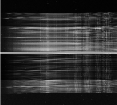
|
Hectospec
|

|
![[TDC Home]](/images/tdc-home.gif)
![[TDC Search]](/images/tdc-search.gif)
![[OIR Home]](/images/oir-home.gif)
|
[Definitions] [Preparation] [Observation] [Reduction] [Pipeline] [Distribution] [Archiving]

|
Hectospec
|

|
![[TDC Home]](/images/tdc-home.gif)
![[TDC Search]](/images/tdc-search.gif)
![[OIR Home]](/images/oir-home.gif)
|
[Definitions] [Preparation] [Observation] [Reduction] [Pipeline] [Distribution] [Archiving]
The data distribution programs were written by Bill Wyatt and are well documented. You can find that documentation at <a>tag. The following notes provide explanation and examples of typical usage.
1. GATHERThe purpose of gather is to collect into a database the set of data you wish to distribute. Although the gather program is primarily used to assemble reduced data from a given run, it is flexible and can also be used for two dimensional data as well as data from different instruments. Another use, not covered here, is to cull raw data that cannot be reduced in the standard pipeline.
An example of the most typical gather command, used after an observing run is:
gather -o gather.db 2001.0324-2001.0411
where o is the output database and a range of directories is given. In this example, taken from FAST data, the directories are the local nights of observation and are on the archive disk.
To collect two dimensional data, use the command:
gather -o output.db -X TF.fits 2001.0324-2001.0411
In this example, TF.fits is the suffix of partially processed FAST files and 2001.0324-2001.0411 are the sub-directories in the reduction directory.
This produces a summary report of the files in gather. When gather is run, this information is given on the monitor but to put it into a file run greport:
greport -i gather.db -o date.report
Here i is obviously input and o, output.
Distribute takes the output of gather and puts it on the distribution disk in specific program directories.
To run distribute for reduced data after the end of a run, type:
distribute -i gather.db -1
To distribute partially processed two dimensional data the command is:
distribute -i gather.db -2
There are a number of options in distribute: distribute can be run on only one program, or just calibrations. See Bill Wyatt's documentation to review the full implementation of distribute.
This command sends a notice to each of the PIs who own data in the current distribution set. The notice contains a list of the PI's data with instructions on how to retrieve it. The permissions are such on the distribute disk that PIs cannot look at the directories; they can only copy their data from the inform list. Like distribute, inform can, if required, send a notice to only one PI.
The typical command for fully reduced, one-dimensional data is:
inform -1 2001.0324-2001.0411
For two-dimensional data it is:
inform -2 2001.0324-2001.0411
To summarize, after reduction of a given run the one-dimensional distribution commands would look like:
gather -o gather.db 2001.0324-2001.0411
greport -i gather.db -o reportname
distribute -i gather.db -1
notify -1 2001.0324-2001.0411